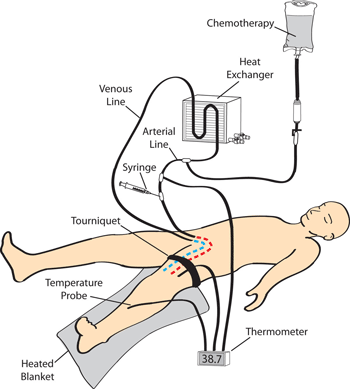
Isolated Limb Infusion (ILI) is a regional technique which involves temporarily isolating the blood supply to an extremity to concentrate chemotherapy treatment there.
It’s a minimally invasive procedure for delivering high doses of chemotherapy to treat recurrent in-transit disease in a limb, including melanoma and sarcoma.
With ILI, the effects of chemotherapy can be concentrated regionally in one area, easing the strain and toxicity on the full body that can accompany standard chemotherapy. It also allows a much higher concentration of the dose than a standard intravenous chemotherapy would permit.
In an Isolated Limb Infusion, a tourniquet is used to stop the blood circulation in the affected limb. A catheter is inserted into both the artery and vein and used to circulate a high dose of the treatment drug into the limb for up to 40 minutes, without the stress on other organs that would normally occur.
When the session is over, the drugs are flushed from the limb, and normal blood flow is returned. The full session can take three hours.
The ILI procedure can safely be repeated if deemed necessary.
Metastatic melanoma and extremity sarcoma are some of the hardest cancers to treat. Treatment for patients with advanced melanoma and sarcoma (that has spread to other parts of the body) may include surgery, radiation therapy, chemotherapy, interferon therapy, biologic/immunotherapy and/or innovative therapies using new drugs to fight the disease. ILI allows concentrated chemotherapy infusion with less strain on the patient.